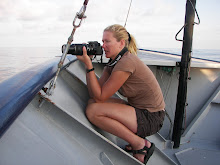 Yesterday we left McMurdo Station and traveled a short distance to a new experimental station located near beautiful Cape Boyds. The cape is home to an Adelie penguin rookery and mesmerizing scenery. Our transit out of McMurdo towards this location was equally incredible. Soon after leaving the dock, a flockof Adelie penguins began swimming ahead of our boat as if to bow ride our large icebreaker. In the mix were 2 emperor penguins – a rare and very enjoyable sight for us on this trip. The emperors were noticeably larger than the Adelies and altogether more colorful. They were also incredibly fast. Many Weddell seals could also be seen resting on the fast ice. We also encountered several minke whales (one of which swam directly under our ship – what a sight!) and approximately 30 orcas as we made our way toward the open water of McMurdo Sound and the Ross Sea Polynya.
Yesterday we left McMurdo Station and traveled a short distance to a new experimental station located near beautiful Cape Boyds. The cape is home to an Adelie penguin rookery and mesmerizing scenery. Our transit out of McMurdo towards this location was equally incredible. Soon after leaving the dock, a flockof Adelie penguins began swimming ahead of our boat as if to bow ride our large icebreaker. In the mix were 2 emperor penguins – a rare and very enjoyable sight for us on this trip. The emperors were noticeably larger than the Adelies and altogether more colorful. They were also incredibly fast. Many Weddell seals could also be seen resting on the fast ice. We also encountered several minke whales (one of which swam directly under our ship – what a sight!) and approximately 30 orcas as we made our way toward the open water of McMurdo Sound and the Ross Sea Polynya.The backdrop for our fourth and latest experiment is stunning. There is a large mountain chain lining the coast which is shadowed here by Mount Erebus, a towering active volcano on Ross Island. Penguin sightings are common as we collect zooplankton samples from their watery world. A new scientific party joined us at McMurdo and so we will soon be leaving this area to accommodate their research needs and to conduct our own experiments in the polynya.

























.jpg)




